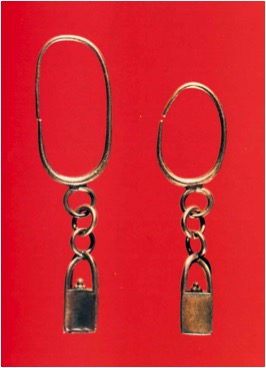Gold earring
The so-called "leech" earring was found in grave 9 AR of the Punic necropolis in Sulky, and can be dated between the sixth and fifth centuries B.C.
The earring’s body consists of an elliptical gold tubular foil, which tapers at the ends: it is a very simple object which unlike other leech earrings which have the classic bulging in the central part of the body (from which the name "leech" because the earring nearly takes on the shape of the animal), here presents two cones joined at their base (figs. 1-2).


The "leech" type of earring is widespread within Phoenician-Punic jewellery, and has a shape which can be simple or decorated by some details, such as pendants (figs. 3-4) or applications of different types, among which those obtained with the filigree and granulating techniques stand out (fig. 5); these seem to be rarer among the specimens found so far in Sulky.



The development of Punic goldsmithing is linked to a very rich artistic tradition which was established for centuries in the Phoenician homeland. The original workshop of the Sulky earring is still unknown and jewellery was often kept for several generations whilst remaining still in use.
What was the function of earrings? As also occurs today, these precious objects were designed to beautify the dead person and also demonstrated belonging to a higher social class or at least to one with great economic possibilities. They often had magical and religious symbols as well, and therefore had a protective and lucky charm role, both during the wearer’s life and during the journey to the afterlife. The Sulky earring has no symbolism of this kind however, and therefore it is more logical to assume that it was a simple ornament.
Bibliografia
- E. ACQUARO, Arte e cultura punica in Sardegna, Sassari 1984.
- P. BARTOLONI, Il museo archeologico comunale “F. Barreca” di Sant’Antioco, Sassari 2007.
- G. PISANO, I gioielli, in Aa. Vv., I Fenici, Milano 1989, pp. 370-393.
- G. QUATTROCCHI PISANO, I gioielli fenici di Tharros nel Museo Nazionale di Cagliari, Roma 1974.

 VR
VR